|

Looking back
Industrial Revolution - Part II
Last week’s article titled
‘Winds of change’ would have enlightened you about the Industrial
Revolution that began in Britain and swept through the rest of the world
eventually.
Today too we feature more valuable information about these
revolutionary changes that started way back in the 18th century, paving
the way for the comforts and benefits we enjoy today.
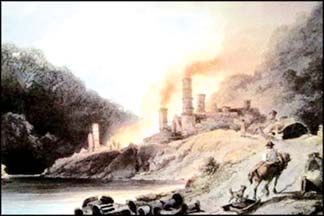 As
we explained in our previous article, the Industrial Revolution was a
time of invention and new developments. As a result of it, over a space
of just a few decades, individual producers of crops, textile, iron and
other products were replaced by modern factories and farms. Machinery
and goods were made of durable materials such as steel and iron and new
sources of power to operate these machines were introduced. As
we explained in our previous article, the Industrial Revolution was a
time of invention and new developments. As a result of it, over a space
of just a few decades, individual producers of crops, textile, iron and
other products were replaced by modern factories and farms. Machinery
and goods were made of durable materials such as steel and iron and new
sources of power to operate these machines were introduced.
The wide-ranging changes resulted in cheaper goods and a comfortable
life. However, it also led to pollution on a wide scale, health hazards
and dull working conditions. Child labour was one of the major negative
impacts of it.
But, despite the negative impacts, it is thanks to the Industrial
Revolution that today we enjoy modern-day items such as the electric
light, the telephone, the aeroplane and also the scientific technology
that enables sending astronauts into space.
The Industrial Revolution was a time of bold inventions. During that
time, many of the inventors had to face criticism from the public and
also face hardship before their work or inventions were recognised and
accepted.When new ways to produce goods on a larger scale, and at lower
prices were introduced, following the various techniques and machinery
deviced by the then inventors, some of the people were reluctant to
accept these changes. One of the major reasons for this opposition to
the sweeping changes was the fact that machines replaced humans and
deprived many of employment. In fact, in 1811 factory owners in
Nottingham were sent threatening letters by a secret group of people.
The group was nicknamed the Luddites. They broke into factories and
destroyed machinery.
The Industrial Revolution continues even today with each new
development in industry and technology we face. So, let’s check out
details about some of the inventors who were responsible for these
changes that have made such a change in the way we live today!
Abraham Darby
Born - April 14 1678 in Dudley, Worcestershire, England.
Died - March 8. 1717
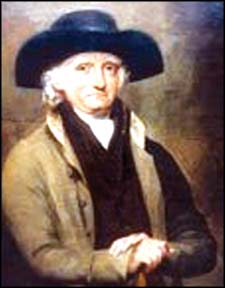 |
|
Coke burning
blast furnace |
 This
English engineer is considered to be the cornerstone of the Industrial
Revolution by many as his development of a method to use coke for
smelting rather than charcoal and wood enabled advanced mass production
of iron and brass items.He invented the coke burning blast furnace in
1709. Coke is a derivative (something developed) of coal which is
produced by heating the coal and removing the sulphur and combustible
impurities from it. Coke delivered hotter, more sustainable heat without
flame. This
English engineer is considered to be the cornerstone of the Industrial
Revolution by many as his development of a method to use coke for
smelting rather than charcoal and wood enabled advanced mass production
of iron and brass items.He invented the coke burning blast furnace in
1709. Coke is a derivative (something developed) of coal which is
produced by heating the coal and removing the sulphur and combustible
impurities from it. Coke delivered hotter, more sustainable heat without
flame.
Improvements to this coke furnace later led to the evolution of the
iron and steel industry which in turn spawned aircraft, automobile and
ship building industries and also other construction work using these
durable materials.
In the 17th century, charcoal was the leading fuel used for stoking
(feeding furnaces). As more and more coal was needed to keep the
furnaces burning continuously, Darby’s blast furnace fuelled by coke was
an important breakthrough.
Eli Whitney
Born - December 8, 1765 in Westboro, Massachusetts,USA
Died - January 8, 1825.
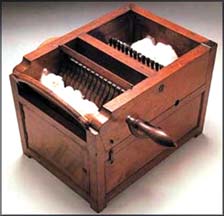 |
|
Model of a
cotton gin |
 Prior
to the Industrial Revolution, farmers in the southern part of the United
States had been growing cotton since the 17th century as the warm, humid
climate was ideal for it. Cotton was one of the growing raw materials
used for clothing. It was grown in huge plantations, but the farmers
could not find a way of processing large amounts of this cotton, keeping
pace with the growing demand for cotton. Prior
to the Industrial Revolution, farmers in the southern part of the United
States had been growing cotton since the 17th century as the warm, humid
climate was ideal for it. Cotton was one of the growing raw materials
used for clothing. It was grown in huge plantations, but the farmers
could not find a way of processing large amounts of this cotton, keeping
pace with the growing demand for cotton.
Slaves were shipped in from Africa to work on the plantations, but
hundreds of man-hours were wasted to separate cotton seeds from the
cotton fibre. Eli Whitney’s development of a cotton gin - a machine
which could generate up to 50 lbs of cleaned cotton on a daily basis in
1793, resulted in a breakthrough for the American cotton producers.
Whitney’s device changed farming in America almost overnight, making
United States the world’s leading cotton producer.
The cotton gin was the first device that helped clean short staple
cotton which was produced in the United States.
A machine known as the Chakra was used in East India to separate
long-staple cotton grown in that region.Whitney’s cotton gin was
improved upon later with horse-powered and water-powered gins to
increase production. As a result cotton became cheaper and the number
one selling textile. Great Britain became the most important market for
American cotton.
Thomas Newcomen
Born - February, 1664 in Dartmouth, Devon England.
Died - August 5, 1729
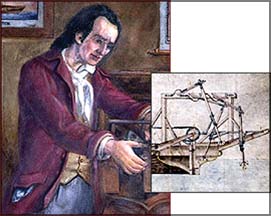 |
|
Drawing of
the steam engine |
He perfected a practical steam engine for pumping water and is
regarded as a forefather of the Industrial Revolution.
Newcomen’s steam engine is believed to have been developed around
1710. He is said to have combined the ideas of Thomas Savery and Denis
Papin to create his steam engine.
The Newcomen’s engine remained without any changes for about three
quarters of a century and spread not only in the UK, but also to
mainland Europe.
Even though his machine was by no means efficient it was useful at
the time of invention. It was however gradually replaced after 1775
(especially in areas where coal was expensive). An improved design was
introduced by James Watt.
James Hargreaves
Born - April 22, 1720 in Knuzden Brook, Oswaldtwistel, Lancashire,
England.
Died - 1778
According to some reports, this English weaver and carpenter (who was
also known as Hargraves) had got the idea to design the spinning jenny
after seeing a one thread wheel overturned upon the floor.
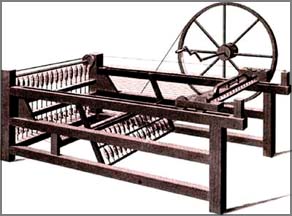 |
|
Model of the
Spinning Jenny |
 He
had noticed how both the wheel and spindle continued to work and
realised that if a number of spindles were placed upright, side by side,
not just one, but several threads could be spun at once. So, he had
improved upon the normal spinning wheel and come up with the
eight-spindles spinning Jenny in 1764. He
had noticed how both the wheel and spindle continued to work and
realised that if a number of spindles were placed upright, side by side,
not just one, but several threads could be spun at once. So, he had
improved upon the normal spinning wheel and come up with the
eight-spindles spinning Jenny in 1764.
Some claim that Hargreaves called his new invention the spinning
Jennifer originally after his daughter while others say it was named
after his wife.
However, by 1768, the invention was called the spinning Jenny.
Even though Hargreaves’ invention was unique, he could not obtain
patent rights for it since he had already marketed his product prior to
his application. But, on July 12, 1770 Hargreaves managed to get patent
rights for a 16 spindle machine he designed.
What’s interesting is that Hargreaves, who went down in history for
his ingenious invention was a person who had received no formal
education. He was never taught how to read or write, but he reached
great heights in life as a result of perseverance.He was not ‘spoon fed’
but self-taught. His invention paved the way for a mechanised textile
industry.
Sir Humphrey Davy
Born - December 17, 1778 in Penzance, Cornwall, England.
Died - May 29, 1829
 |
|
Miner’s
safety lamp |
 He
was a British chemist known for his numerous experiments in electro
chemicals. He is known as the ‘Father of electrolysis’. His expertise in
the field was sought by a group of miners from Newcastle when mining
disasters caused by explosions began to grow during that time. He
was a British chemist known for his numerous experiments in electro
chemicals. He is known as the ‘Father of electrolysis’. His expertise in
the field was sought by a group of miners from Newcastle when mining
disasters caused by explosions began to grow during that time.
With the growing demand for coal, mines were dug deeper and deeper.
This resulted in risks. One obvious risk was that the mines themselves
could collapse and the other was that methane gas and coal dust (both
highly inflammable) could collect in the deep mines and trigger
explosions when they came into contact with a miner’s candle or spark
from a metal tool.
As Humphrey was knowledgeable about gases, he was approached after an
explosion killed 92 men and boys.
He is credited with designing the first miner’s safety lamp. This
lamp was built with a wire mesh which screened the flame and prevented
sparks from escaping.
He is responsible for the discovery of the anaesthetic effect of
nitrous oxide in 1799 which was a major contribution to surgery.He
became a fellow of the Royal Society in 1803, was knighted in 1812 and
became a baronet in 1818.
His Davy lamp became famous. However he’s not the only person to
design a safety lamp. Even George Stephenson designed one. |

